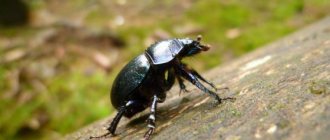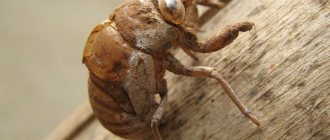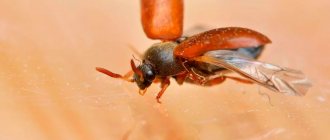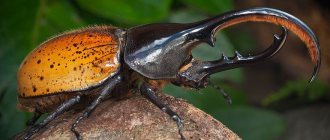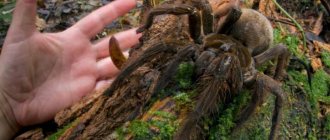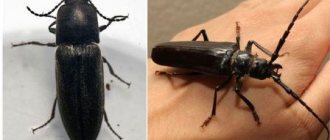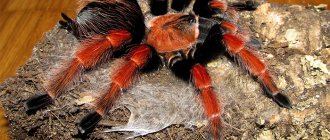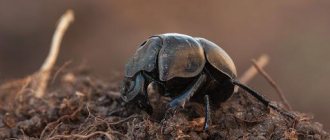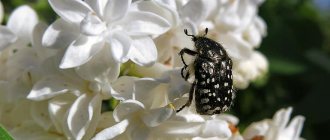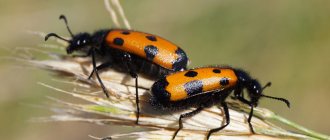Dung beetles love manure. The Egyptians believed that scarabs rolled the sun across the sky. Humans invented wheeled motion in 3500 BC, and shrew beetles used this technology to move dung pellets 50 million years before the pyramids.
The easiest way to move something is to roll it into a ball. Manure is sticky, so when it rolls, it picks up even more manure particles. It's like creating the parts of a snowman.
Fighting the rhinoceros beetle
The rhinoceros beetle is listed in the Red Book and is therefore considered an endangered species. Despite this, many gardeners try to get rid of its larvae, which are not averse to feasting on the future harvest. In this case, humane methods are more suitable to combat this insect. It is enough to catch adult beetles so that they cannot lay eggs. To do this, you can use different types of traps.
Chemicals
It is not recommended to use insecticides against rhinoceros beetles, but if conditions require it, you can use:
Natural enemies
Insects that feed on excrement emit a disgusting odor that repels almost anyone who might eat the bugs. Domestic chickens, crows, and omnivorous hedgehogs do not disdain dung beetles. Young, inexperienced foxes may try to eat the dung beetle due to lack of food. To scare away potential enemies, the beetle makes disgusting creaking sounds by rubbing its abdomen and elytra, and also pretends to be dead.
The body of a dung beetle can be parasitized by a special tiny mite, Gamasuscoleoptratorum, which, with its sharp jaws, bites through the insect’s hard shell and attaches itself. One dung beetle can be the host of several mites at once.
Prevalence
Hercules belongs to the lamellar family, the genus Duplyaki. These are the largest representatives of the genus (in general, their number is about 300), which “bear” outgrowths on themselves. The beetle's closest relatives are the rhinoceros beetle, the elephant beetle, and the scarab.
Hercules is native to South America. He also lives in Bolivia, Venezuela, the Caribbean, Ecuador, Peru, Central American regions, Dominican Republic, Mexico, Bolivia, Antilles, Colombia, Brazil, Panama, Guadeloupe. Favorite places are moist forests of subtropical and tropical zones, where a lot of greenery and fruit grow. But sometimes during wet periods they can be found in lowland and mountain forests. They prefer to live on the forest floor. Larvae live in rotting wood, which also serves as food, while adults prefer to live at the base of trees.
Habitat of skorobei
Most species of the scarab genus live in the Afrotropical region, since the hot climate of this area is excellent for these insects. About 20 species can be found in the Palearctic region, in countries such as:
- France;
- Spain;
- Bulgaria;
- Greece;
- Ukraine;
- Kazakhstan;
- Türkiye;
- southern regions of Russia.
It is worth noting that scarab beetles are not found on the mainland of Australia and the entire Western Hemisphere.
Why do dung beetles roll balls?
A black beetle rolling a ball is a nurse beetle, clearing the earth of sewage, at work. This, which has created its fame since ancient times, is the sacred beetle - the scarab. But cleaning the soil is not the beetle's main goal. The main thing is food preparation, since the beetle is very gluttonous and can eat several times the volume of its body in one meal. The beetle is an individualist, preferring to eat alone. But how to deliver food? To do this, he makes a ball so that it can be rolled away from the pile of manure. Even the ancient Egyptians noticed that the path along which the beetle rolls the balls coincides with the movement of the Sun. Moving away from the heap, when the molded ball is delivered to the place of the meal, and the beetle rolls it upside down so as not to go astray, it stops, climbs onto the ball and works like a locator, orienting itself in space. Having found a convenient place, the beetle tears off a hole, hides in it with a ball, blocks the entrance and begins to eat.
It was believed that the ball served as a place for laying eggs, but this was not a dwelling, but only food. To continue the offspring, the female beetle sculpts a dung “pear” into which the egg is laid; it is, at the same time, both a cradle and food for the future beetle. But that's another topic.
Almost more than one hundred and seventy years ago, a similar question was asked by a boy who later devoted his life to studying the life of insects, his name was Jean Henri Fabre, and he also studied the secret of the balls.
The sacred scarab is one of the representatives of dung beetles (family Lamelidae), widespread in North Africa and the countries of Southern and Western Europe.
Scarabs are the real strongmen of the insect world: the balls of dung they roll often reach such a size that they become larger than the beetle itself. It is interesting that the front legs of the scarab seem to be created exclusively for sculpting and rolling balls: they are very strong, dexterous and are never used by the beetle for any other purpose.
What does it look like
The length of the sacred scarab (Scarabaeus sacer) reaches 25–37 mm. The tar-black body is covered with a durable chitinous cover - the exoskeleton (external skeleton). The color acquires a brilliant sheen as it matures. The inner edges of the male's hind legs are covered with golden-red fringe - this is the main difference between the male and female. The head has a serrated clypeus. The pronotum and elytra have a granular texture.
Lifestyle, nutrition and reproduction
The main activity is rolling balls of manure. A fierce fight can break out between several beetles over the finished ball. Most often, scarabs can be seen in the fields, where they gather around piles of dung of ungulates and make balls from it. Then the male and female roll the ball away from the dung heap and bury it in the ground. Most often, these balls serve as food for the beetles, but the female uses some of them to lay eggs.
How to fight
Blisters pose a great threat to the crop, so it is necessary to take preventive measures in advance. It is necessary to plow land and vegetable gardens in a timely manner; by digging up areas, you can get rid of already laid eggs and reduce the number of insects.
It is also necessary to destroy beetles on ripening crops; for this, the affected plants are treated with special solutions; this must be done strictly with protective gloves and according to the instructions, because the compositions contain poisons.
To eliminate pests from flower buds, you need to resort to lighter insecticidal agents so as not to destroy the plant. During flowering, chemical compounds cannot be used.
In this video you will find some interesting facts about blisters:
You can collect insects by hand and put them in a jar with a salty solution; such a mixture is destructive for these insects. They also do not tolerate tobacco dust, so it is permissible to use this processing method.
The only natural savior from blister can be a hedgehog. The dangerous poison of the beetles does not affect these animals and they eat them with pleasure.
Description and features
Dung beetles are representatives of the order Coleoptera, belong to the family Lamelidae and are included in the numerous subfamily of shrews. What a dung beetle looks like depends on a number of factors, in particular the species to which it belongs and its habitat. Thus, the size of the imago can vary from 1 to 7 cm, weight - from 0.75 to 1.5 g. The color can be black, brown, blue, green, yellow.
Moreover, all adult insects have:
- oval or round body shape;
- head directed forward;
- antennae consisting of 11 segments and ending in fan-shaped plates;
- three pairs of legs with serrated tibiae along the outer edge and 2 spurs on the apex;
- abdomen, consisting of 6 sternites, on which 7 spiracles are located;
- mouthparts of the gnawing type.
Also, all beetles have strong, thick, chitinous elytra, under which are leathery wings. But not all drillers can fly; some have completely lost the ability to move through the air.
Interesting! During flight, the elytra of dung beetles practically do not open. This contradicts all the laws of aerodynamics, but does not interfere with the insects themselves. Their flight is so masterly and precise that they can easily catch a moving fly (even many birds cannot do such a trick!)
Kinds
Today, scientists classify 750 species of beetles as dung beetles, divided into two main groups: Coprophaga and Arenicolae. The main difference between representatives of both groups is that the beetles belonging to Coprophaga have covered and leathery upper lips and jaws. In Arenicolae these parts are hard and uncovered.
The most famous types include:
- Common dung beetle (Geotrupes stercorarius L.). Typical representative. Length 16-27 mm. On top, the body is black in color with a pronounced shine; sometimes blue or green tints or a border can be observed. The lower part of the body is purple or blue (specimens with a greenish-blue abdomen are much less common). There are 7 distinct grooves on the fender covers.
Adult beetles can be found everywhere from April to November.
- Forest dung beetle (Anoplotrupes stercorosus). Mass view. The adult size is 12-20 mm. The elytra are blue-black and have seven dotted grooves, the belly is blue with a metallic tint. Beneath the chitinous elytra are wings, which can be green, purple or brown. The antennae have a red-brown tint and large “pins” at the tips.
The period of activity of the beetle is summer, from mid-May to the first ten days of September. During this time, he manages to prepare holes with cameras and lay eggs in them.
- Spring dung beetle (Trypocopris vernalis). A rare species, listed in the Red Book of several regions of the Russian Federation and Belarus.
The body length of the insect is 18-20 mm, its shape is oval and convex. The surface of the elytra seems almost perfectly smooth, since there are practically no grooves on them. There are many small dots on the wide pronotum. There are individuals of dark blue, black-blue and green colors (the latter are very similar to bronzes, but differ from them in their lifestyle). Activity time is summer.
- The bull beetle (Onthophagus taurus). The length of the flattened body of this insect is 15 mm. It got its name for its paired outgrowths resembling horns. They can be located on the back, front or middle of the head and are found exclusively in males.
In exceptional cases, beetles do not grow horns, but in this case their “masculinity” is confirmed by enlarged genitals. Also among the most common and recognizable species of dung beetles are the rhinoceros beetle and the sacred scarab.
Modern meaning of the talisman
Now they believe that the image of an insect helps in the afterlife and earthly life. Such amulets protect against evil spirits, negative energy, energy vampirism and other misfortunes. They help with business, creating a family, harmonizing a couple’s relationship and helping them find love.
Such a souvenir from the country of feasts will make the owner confident and harmonize energy. It brings incredible luck in literally everything, the desire to work for your own benefit, destroys laziness and helps you achieve prosperity and success. But he won’t do anything for you, he will teach you wisdom and give you the ability to see the true nature of everything that happens to you.
For women, the scarab brings youth and beauty, internal magnetism and charm. Men are endowed with perseverance and consistency. But the influence of the amulet does not depend on gender. When you lack luck in business, luck in finding a suitable partner, or motivation to work on yourself, turn to the amulet. It also has a positive effect on sexuality, increases libido, and relieves impotence and infertility.
Why do you dream about a scarab?
Dreams often prompt a person to solve a problem or warn of danger. Of course, a sacred insect in a dream carries a certain meaning that is important to interpret correctly. To understand why the scarab beetle dreams, you should remember all the details of the dream and refer to several dream books:
— Miller’s Dream Book: the scarab makes it clear that success can only be achieved if you devote yourself to the task with your head and make efforts to complete the task;
— Gypsy dream book: an insect promises good luck and approves of the path chosen by the dreamer, but only if you dreamed of a flying scarab;
— Eastern dream book: if the beetle was in the mouth, the dream should be interpreted as a warning about imprudence and careless words. You should think before making fiery speeches, because they can lead to undesirable consequences;
— Aesop’s dream book: finding a scarab in your own bed means that you will soon find a soul mate;
— Assyrian dream book: if a beetle from a dream bites, this can be regarded as a warning about the hidden influence of other people on the dreamer’s fate. If the bite passes without a trace, there is nothing to be afraid of; if an abscess is seen in its place, the actions of the enemies will bring them the desired result;
— Noble dream book: a large scarab promises unpleasant secrets around the person who dreamed about it. They will bring with them a threat to well-being and negatively affect relationships with loved ones;
— Modern dream book: A scarab beetle seen in a young girl’s dream promises a quick marriage, but if the insect crawled away, the marriage will not last long.
If in a dream the scarab was not just static, but moved or interacted with the dreamer in some way, this leaves an imprint on the interpretation of the dream:
- an insect covered in amber means that you will soon have to take on the burden of responsibility for the fate of another person;
- a precious decoration in the form of a scarab symbolizes unexpected wealth - winning a lottery, inheritance or bonus;
- the image of a beetle on household items promises the dreamer harmony in family life and improved relationships with children and spouse;
- a feeling of disgust in a dream towards a scarab or its specific food indicates that in reality unpleasant rumors are being spread about the dreamer, which can ruin relationships with loved ones;
— a dung beetle in a plate warns against concluding important transactions, especially with unverified people: there is a high probability of losing money;
- if the scarab crossed the road or was simply on the way, there will be a meeting that will affect the dreamer’s fate.
The scarab, despite its frightening appearance and gloomy color, does not promise major troubles or health problems in a dream. Unlike many other insects, it becomes a harbinger of success, provided that effort is invested in achieving it.
Reproduction and lifespan
Dung beetles live up to 2-3 years and, like other Coleoptera, are insects with complete metamorphosis.
The male lures the female by releasing a stream of an odorous substance - a pheromone, urging her to mate. Usually, the gentleman brings the lady a gift - a ball of manure. The female digs a hole up to 60 cm deep with a slight widening at the end. A brood ball of dung is placed in this chamber, into which the female lays one fertilized egg. Dung beetles do not care for their offspring.
The insect has 4 stages of development.
- The egg develops in a burrow, in a warm substrate.
- Then a larva appears from it, outwardly completely different from the adult insect. The body of the dung beetle larva is fat, whitish, the head is small, hard, dark in color with small antennae.
- The creature feeds on stored dung, then pupates.
- In spring, an imago, an adult, emerges from the pupa.
Interesting fact! A female dung beetle can produce a maximum of 6 eggs (usually less), so she carefully chooses a partner for mating.
Nutrition
What the dung beetle eats is clear from its name. Coprophagous insects eat excrement to obtain nutrients from semi-digested remains.
Interesting fact! Some species of dung beetles prefer especially odorous feces of primates - monkeys and humans.
Some beetles prefer not manure at all:
- Some species eat mushrooms and fruits, preferably rotten ones.
- They do not disdain dead flesh, carrion, dead insects and protozoa.
- One species has adapted to living on the back of giant snails. They feed on the mucus of these mollusks.
- Recently, scientists have been interested in the predatory dung beetles that live in Brazil and Peru - Deltochilum valgum. The beetles lie in wait for giant ants and centipedes, behead them, roll the carcass into a hole and eat it there.
Interesting fact! Up to 16 thousand dung beetles can fly to a pile of elephant dung weighing 1.5 kg.
What does it eat?
The Egyptians believed that there were scarabs that eat people, they crawl under the skin through the ears, nose and eat a person from the inside.
Interesting!
Science has proven that the carnivorous species of beetles does not exist; the studied species are absolutely safe for people and animals.
Their diet consists of manure, which is what earned them universal love back in ancient times. Dung beetles are capable of processing large amounts of manure within a short time, which remains when keeping domestic animals. Scarabs can also be considered orderlies in the wild. It would take four thousand scarabs just an hour to clear an average pile of dung.
In the middle zone, beetles begin their active life as soon as the air warms up. They purify themselves only during the day until mid-summer, and then switch to a nocturnal lifestyle. For normal existence for 10-14 days, the scarab needs one ball of dung, five times the size of the insect itself. The beetle rolls it into a pre-dug hole near its home and digs it in. This is how a young beetle acts; at a more mature age, the male and female prepare larger amounts of manure for future use. It is with the help of waste of this type that procreation in these insects is possible.
Scarab beetle
In order to prepare food for itself, the scarab rolls a ball of dung, and it does it quite funny:
- the basis is most often a small round piece of feces;
- with the edge of its head, the insect seems to cut off small pieces of manure;
- presses the torn piece into the ball with its front and hind paws;
- the middle pair of paws holds the lump tightly, not letting go until the formation process is completed.
The beetle rolls the finished ball into a safe shelter in a shaded place. On the way, he is very careful, because smaller beetles in larger numbers can take away the prey without any problems. And relatives of the same build will not disdain ready-made food.
Interesting!
Manure not only helps scarabs live, the appearance of offspring also depends on it. The female and male stock up on a sufficient amount of manure, lay it out in their burrows, and then the female lays eggs in specially fashioned capsules. Until the pupal state, they feed on the dung that their parents stored for them.
Benefits for the environment
The dung beetle rolls waste balls for a reason. It moves excrement, helping to clean the area. By burying manure, beetles fertilize the soil. Dung beetles also help disperse plant seeds over long distances.
Ball rolling
Scientists have proven the invaluable contribution of burrowing beetles to the well-being of ecosystems associated with industrial cattle breeding.
Interesting fact! In the 60s of the 20th century, Australian authorities became concerned with the problem of disposing of manure that remained in fields and meadows as animal waste. Evolutionarily endemic species (inhabiting a certain territory) could only process solid feces of local marsupial inhabitants. Dung beetles were brought to Australia from other countries, the digestion of which was adapted to the processing of cow “pats”. Literally within a season, the dung beetles coped with the task.
Reducing the amount of manure reduces the number of flies that carry infections dangerous to livestock. By processing animal excrement, dung beetles reduce the emission of methane and greenhouse gases into the atmosphere by 40%.
The tunnel holes dug by dung beetles enrich the soil with oxygen.
What types of scarab beetles are found in Europe and the CIS countries
The habitat of scarabs covers the southern part of Europe and the countries of Central Asia. The species diversity in this area includes about 20 species. On the territory of Russia, only a few species of beetles from the genus Scarabs are usually found. The most common and well-known among them are:
- sacred scarab;
- Typhon scarab;
- Scarab Sisyphus.
